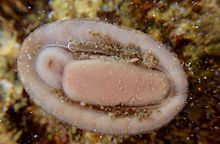Radsia nigrovirescens
| Radsia nigrovirescens | |
|---|---|

| |
| Scientific classification | |
| Domain: | Eukaryota |
| Kingdom: | Animalia |
| Phylum: | Mollusca |
| Class: | Polyplacophora |
| Order: | Chitonida |
| Family: | Chitonidae |
| Genus: | Radsia |
| Species: | R. nigrovirescens
|
| Binomial name | |
| Radsia nigrovirescens (Blainville, 1825)
| |
| Synonyms | |
| |
Radsia nigrovirescens, the brooding chiton, is a small polyplacophoran mollusc in the family Chitonidae,[1] found on the west coast of southern Africa.
Description[edit]
The valves of the shell are dark brown to black and bear indistinct radiating ridges. The girdle is of a rufous color and has a black band; it is covered with large, smooth scales that may have a coppery sheen. Individuals are 10–25 mm in length.[2]
Distribution and habitat[edit]
Radsia nigrovirescens occurs along the western portion of the south coast of Africa, from Cape Columbine in Namibia to Cape Agulhas in South Africa. The species forms tightly packed groups that can be found under stones below the inter-tidal zone.[2]
Ecology[edit]

The species derives its common name from the unusual adaptation of brooding its eggs under its girdle, protecting them until they develop into fully formed baby chitons.[2]
References[edit]
- ^ E. Schwabe (2015). "Radsia nigrovirescens". WoRMS. World Register of Marine Species. Retrieved 28 December 2016.
- ^ a b c Branch, G. M.; Griffiths, C. L.; Branch, M. L.; Beckley, L. E. (2010). Two Oceans: a Guide to the Marine Life of Southern Africa. Cape Town: Struik Nature. ISBN 9781775848363.
